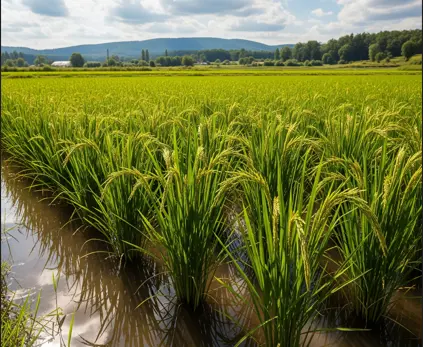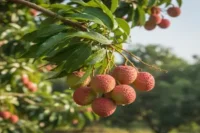Recommended Dose of Fertilizer For Rice Farming: Easy Steps for Better Yield
Published: 12 Aug 2025
A fertilizer plan is a step-by-step guide that tells you what type of fertilizers to use. This guide also describes how much and when to apply it for your crop. Rice needs a balanced diet to stay healthy; rice crops also need the right nutrients at the right time to grow well.
Rice crops need a proper fertilizer plan because soil nutrients alone are not always enough to meet the plant’s needs. Rice can grow in different types of soil and climates. Without a clear plan, there’s a higher chance of giving too much or too little fertilizer, which can hurt plant health and reduce yield.
Following the right fertilizer schedule brings many benefits:
- It improves the size and quality of the grains.
- It prevents waste of fertilizers, saving money and protecting the environment.
- It helps rice plants grow faster and healthier.
A good fertilizer plan is for boosting yield. It also gives the rice crop exactly what it needs, at the right time, for a healthy and sustainable harvest.

Understanding the Nutrient Needs of Rice
Rice plants, like all crops, need a balanced supply of nutrients to grow strong and produce high yields. The three main nutrients are nitrogen (N), phosphorus (P), and potassium (K). These are often called primary nutrients because they are required in larger amounts compared to other elements.
Main Nutrients for Rice Growth
- Nitrogen (N) – Nitrogen is the most important nutrient for rice. It helps plants grow tall, develop more leaves, and produce more tillers (side shoots). A good nitrogen supply means greener and healthier plants. Without enough nitrogen, rice plants turn yellow and grow slowly.
- Phosphorus (P) – Phosphorus supports strong root growth and helps plants mature on time. It plays a big role in energy transfer within the plant, which is important for flowering and grain formation. Rice plants lacking phosphorus may have stunted growth and delayed maturity.
- Potassium (K) – Potassium strengthens plant stems, improves water use, and increases resistance to diseases and pests. It also enhances grain filling, resulting in heavier and higher-quality rice grains. A potassium shortage can lead to weak plants and poor grain quality.
Role of Each Nutrient in Rice Plant Health
- Nitrogen: It boosts leaf growth, tillering, and overall plant size.
- Phosphorus: It improves root health, flowering, and seed development.
- Potassium: It increases plant strength, stress resistance, and grain weight.
Each nutrient works together to keep the plant healthy. If even one is missing, plant growth and yield can suffer.
How Nutrient Needs Change During the Rice Growth Stages
Rice plants do not need the same nutrients all the time. Their needs change as they grow:
- Early Stage (Seedling to Tillering): Plants need more nitrogen for leaf and stem growth.
- Mid Stage (Panicle Initiation): Plants need more phosphorus and potassium for flowering and panicle formation.
- Grain Filling Stage: Nitrogen and potassium are most important for developing healthy, heavy grains.
By understanding these needs, farmers can give the right nutrients at the right time, which helps avoid waste and increases yield.
Fertilizer Plan by Growth Stages
A proper fertilizer plan works best when matched to the rice plant’s growth stages. Applying the right nutrients at the right time ensures healthy plants, better yields, and efficient use of fertilizers.
Before Planting (Land Preparation Stage)
Land preparation is a very important aspect for gaining a high production rate per acre.
Importance of Soil Testing
Before planting, test the soil to know its nutrient level. This helps decide how much fertilizer is needed. Soil testing also prevents the overuse of chemicals, which can harm the environment.
Recommended Base Fertilizers
During land preparation, apply phosphorus (P) and potassium (K) as a base dose. These nutrients move slowly in the soil, so early application helps them reach the roots when plants start growing.
Organic Matter and Compost Application
You should add well-rotted compost or farmyard manure. Organic matter improves soil structure, retains water more effectively, and gradually releases nutrients to the crop.
Early Growth Stage (Seedling to Tillering)
After planting, the plant growth stage is very important from the seedling to tillering.
Nitrogen Boost for Strong Plant Growth
At this stage, rice plants grow leaves and tillers. Apply nitrogen (N) in split doses to promote lush, green growth and increased tiller production.
Balanced NPK Mix for Root Development
Along with nitrogen, a balanced mix of NPK supports strong root growth, which is key for nutrient uptake.
Mid-Growth Stage (Panicle Initiation)
Panicle initiation is also an important growth stage for getting good production per acre.
Phosphorus and Potassium Application
When panicles (flower heads) start forming, plants need extra phosphorus and potassium to ensure proper flowering and grain development.
Foliar Sprays for Quick Nutrient Uptake
Apply foliar sprays containing micronutrients like zinc and iron. This ensures quick absorption through leaves, helping plants stay healthy during reproductive growth.
Grain Filling Stage
The last stage is called the grain filling stage, during which grain weight increases day by day.
Final Nitrogen Application for Better Grain Quality
Give a final small dose of nitrogen to improve grain filling and increase grain weight.
Micronutrients for Healthy Seeds
Apply micronutrients such as boron and zinc to improve seed quality and reduce empty grains. Fertilizer Plan Table for Rice Crop
Recommended Dose of Fertilizer For Rice
Under is giving a fertilizer chart for gaining a good average per acre.
| Growth Stage | Fertilizer Type | Main Nutrients Needed | Purpose |
| Before Planting | Base fertilizers + compost | Phosphorus, Potassium | Strengthen roots, improve soil health |
| Early Growth (Tillering) | Nitrogen + Balanced NPK | Nitrogen, Phosphorus, Potassium | Boost leaves, tillers, and roots |
| Mid-Growth (Panicle Initiation) | P & K fertilizers + Foliar sprays | Phosphorus, Potassium, Micronutrients | Support flowering and grain set |
| Grain Filling | Small nitrogen dose + micronutrients | Nitrogen, Zinc, Boron | Improve grain size and quality |
Organic vs. Chemical Fertilizers for Rice
Fertilizers can be organic or chemical, and both have their place in rice farming. Understanding their benefits and drawbacks helps farmers make the right choice for their fields.
Benefits and Drawbacks of Organic Fertilizers
Organic fertilizers are important for the rice crop. They have many benefits and drawbacks.
Benefits:
There are many benefits of organic fertilizer, some of which are given under.
- Improve soil structure and water-holding capacity.
- Release nutrients slowly, providing long-term soil health.
- Encourage beneficial soil microbes.
- Eco-friendly and safe for the environment.
Drawbacks:
Some drawbacks are given here.
- Nutrients are released slowly, so results take time.
- Need large quantities to meet crop needs.
- Quality may vary depending on the source.
Benefits and Drawbacks of Chemical Fertilizers
Chemical fertilizers also have benefits and drawbacks for rice crop farming.
Benefits:
Here are some benefits of chemical fertilizer.
- Provide nutrients quickly for fast plant growth.
- Easy to measure and apply.
- Help meet high nutrient demand during peak growth stages.
Drawbacks:
Here are some drawbacks of chemical fertilizers.
- Overuse can damage soil health over time.
- It can cause nutrient leaching into water sources.
- It may harm beneficial soil organisms if applied in excess.
Using a Combination for Best Results
The best approach for rice farming is often a balanced use of both organic and chemical fertilizers. Organic matter keeps the soil fertile in the long run, while chemical fertilizers supply quick nutrients during critical growth stages.
For example:
- Use compost or farmyard manure during land preparation.
- Add chemical NPK fertilizers in split doses during the growing season.
This way, farmers get healthy soil, strong plants, and better yields without harming the environment.
Conclusion
A good fertilizer plan is the key to growing a healthy and high-yielding rice crop. The best practices include testing the soil before planting, applying the right nutrients at each growth stage, and using a mix of organic and chemical fertilizers for balanced results.
By giving nitrogen, phosphorus, potassium, and micronutrients at the right time, farmers can help rice plants grow strong, produce full grain heads, and improve grain quality. Avoiding common mistakes like overuse of nitrogen or skipping soil tests makes a big difference. Farming is more successful when it’s planned. A proper fertilizer schedule not only increases yield but also keeps the soil healthy for future crops. Follow your plan, care for your soil, and your rice fields will reward you with a rich harvest.
FAQs About the Best Fertilizer For Rice Crop
In this section, we will discuss questions and their most relevant answer.
Which fertilizer is best for rice crops?
The best fertilizer for rice crops is a balanced NPK fertilizer that provides Nitrogen (N) for growth, Phosphorus (P) for root development, and Potassium (K) for grain quality. A common choice is urea for nitrogen, DAP (Diammonium Phosphate) for phosphorus, and MOP (Muriate of Potash) for potassium. The exact amount should be based on soil testing.
Which fertilizer is best for the rice crop in Pakistan?
In Pakistan, farmers often use a combination of:
Urea (for nitrogen)
DAP (for phosphorus and some nitrogen) SOP (Sulphate of Potash) or MOP (for potassium)
The ideal mix depends on the province, soil type, and rice variety. For example, Basmati rice usually needs more potassium for better grain quality.
How to apply fertilizer for rice?
Before planting: Apply all phosphorus and potassium as a base dose during land preparation.
Early growth (tillering): Apply 1/3 of the nitrogen.
Mid-growth (panicle initiation): Apply another 1/3 nitrogen dose and any needed micronutrients. Grain filling stage: Apply the final 1/3 nitrogen dose to improve grain size and quality.
Always keep the field properly watered when applying fertilizers to help nutrient absorption.
What is the NPK ratio for rice per acre?
A common NPK recommendation for rice per acre is 60:30:30 (Nitrogen:Phosphorus: Potassium) in kilograms.
This can change depending on soil fertility. For example:
Low-fertility soils may need 80:40:40. Fertile soils may need 40:20:20.
Soil testing is the best way to decide the exact ratio for your field.

- Be Respectful
- Stay Relevant
- Stay Positive
- True Feedback
- Encourage Discussion
- Avoid Spamming
- No Fake News
- Don't Copy-Paste
- No Personal Attacks



- Be Respectful
- Stay Relevant
- Stay Positive
- True Feedback
- Encourage Discussion
- Avoid Spamming
- No Fake News
- Don't Copy-Paste
- No Personal Attacks




